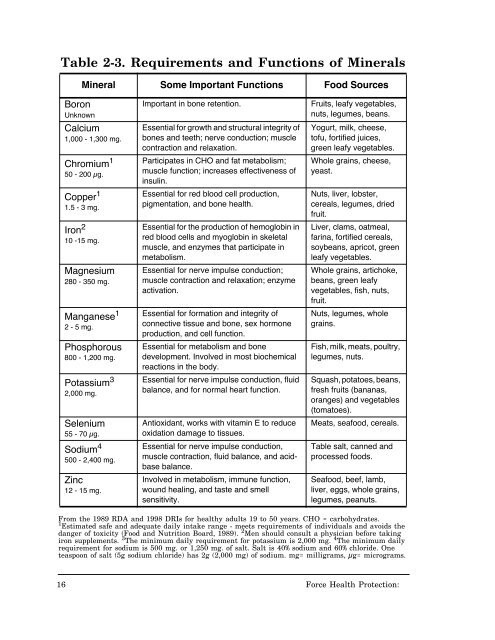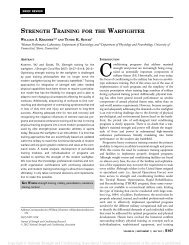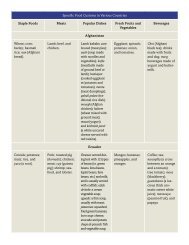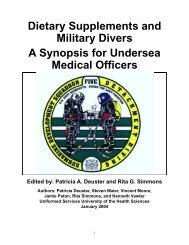Force Health Protection: Nutrition and Exercise Resource Manual
Force Health Protection: Nutrition and Exercise Resource Manual
Force Health Protection: Nutrition and Exercise Resource Manual
You also want an ePaper? Increase the reach of your titles
YUMPU automatically turns print PDFs into web optimized ePapers that Google loves.
Table 2-3. Requirements <strong>and</strong> Functions of Minerals<br />
Mineral Some Important Functions Food Sources<br />
Boron<br />
Unknown<br />
Calcium<br />
1,000 - 1,300 mg.<br />
Chromium 1<br />
50 - 200 µg.<br />
Copper 1<br />
1.5 - 3 mg.<br />
Iron 2<br />
10 -15 mg.<br />
Magnesium<br />
280 - 350 mg.<br />
Manganese 1<br />
2 - 5 mg.<br />
Phosphorous<br />
800 - 1,200 mg.<br />
Potassium 3<br />
2,000 mg.<br />
Selenium<br />
55 - 70 µg.<br />
Sodium 4<br />
500 - 2,400 mg.<br />
Zinc<br />
12 - 15 mg.<br />
Important in bone retention.<br />
Essential for growth <strong>and</strong> structural integrity of<br />
bones <strong>and</strong> teeth; nerve conduction; muscle<br />
contraction <strong>and</strong> relaxation.<br />
Participates in CHO <strong>and</strong> fat metabolism;<br />
muscle function; increases effectiveness of<br />
insulin.<br />
Essential for red blood cell production,<br />
pigmentation, <strong>and</strong> bone health.<br />
Essential for the production of hemoglobin in<br />
red blood cells <strong>and</strong> myoglobin in skeletal<br />
muscle, <strong>and</strong> enzymes that participate in<br />
metabolism.<br />
Essential for nerve impulse conduction;<br />
muscle contraction <strong>and</strong> relaxation; enzyme<br />
activation.<br />
Essential for formation <strong>and</strong> integrity of<br />
connective tissue <strong>and</strong> bone, sex hormone<br />
production, <strong>and</strong> cell function.<br />
Essential for metabolism <strong>and</strong> bone<br />
development. Involved in most biochemical<br />
reactions in the body.<br />
Essential for nerve impulse conduction, fluid<br />
balance, <strong>and</strong> for normal heart function.<br />
Antioxidant, works with vitamin E to reduce<br />
oxidation damage to tissues.<br />
Essential for nerve impulse conduction,<br />
muscle contraction, fluid balance, <strong>and</strong> acidbase<br />
balance.<br />
Involved in metabolism, immune function,<br />
wound healing, <strong>and</strong> taste <strong>and</strong> smell<br />
sensitivity.<br />
Fruits, leafy vegetables,<br />
nuts, legumes, beans.<br />
Yogurt, milk, cheese,<br />
tofu, fortified juices,<br />
green leafy vegetables.<br />
Whole grains, cheese,<br />
yeast.<br />
Nuts, liver, lobster,<br />
cereals, legumes, dried<br />
fruit.<br />
Liver, clams, oatmeal,<br />
farina, fortified cereals,<br />
soybeans, apricot, green<br />
leafy vegetables.<br />
Whole grains, artichoke,<br />
beans, green leafy<br />
vegetables, fish, nuts,<br />
fruit.<br />
Nuts, legumes, whole<br />
grains.<br />
Fish, milk, meats, poultry,<br />
legumes, nuts.<br />
Squash, potatoes, beans,<br />
fresh fruits (bananas,<br />
oranges) <strong>and</strong> vegetables<br />
(tomatoes).<br />
Meats, seafood, cereals.<br />
Table salt, canned <strong>and</strong><br />
processed foods.<br />
Seafood, beef, lamb,<br />
liver, eggs, whole grains,<br />
legumes, peanuts.<br />
From the 1989 RDA <strong>and</strong> 1998 DRIs for healthy adults 19 to 50 years. CHO = carbohydrates.<br />
1 Estimated safe <strong>and</strong> adequate daily intake range - meets requirements of individuals <strong>and</strong> avoids the<br />
danger of toxicity (Food <strong>and</strong> <strong>Nutrition</strong> Board, 1989). 2 Men should consult a physician before taking<br />
iron supplements. 3 The minimum daily requirement for potassium is 2,000 mg. 4 The minimum daily<br />
requirement for sodium is 500 mg. or 1,250 mg. of salt. Salt is 40% sodium <strong>and</strong> 60% chloride. One<br />
teaspoon of salt (5g sodium chloride) has 2g (2,000 mg) of sodium. mg= milligrams, µg= micrograms.<br />
16 <strong>Force</strong> <strong>Health</strong> <strong>Protection</strong>:






![Body Composition and Military [PDF] - Human Performance ...](https://img.yumpu.com/43269347/1/190x245/body-composition-and-military-pdf-human-performance-.jpg?quality=85)
![Tips for Grocery Shopping [PDF]](https://img.yumpu.com/37447379/1/190x245/tips-for-grocery-shopping-pdf.jpg?quality=85)



![Synthetic Drugs [PDF] - Human Performance Resource Center](https://img.yumpu.com/37447322/1/190x245/synthetic-drugs-pdf-human-performance-resource-center.jpg?quality=85)


